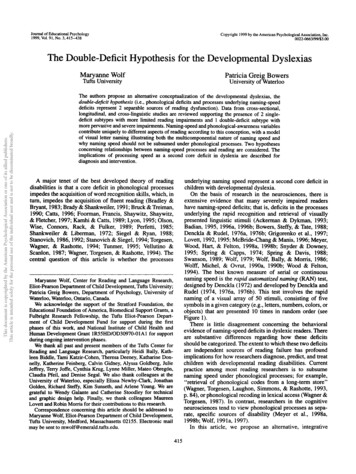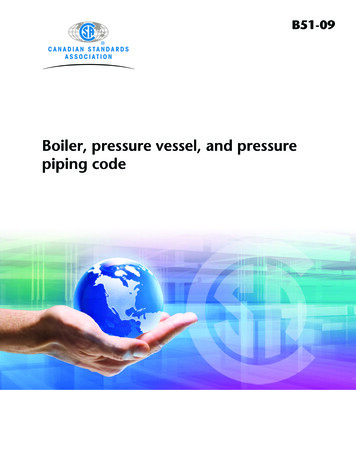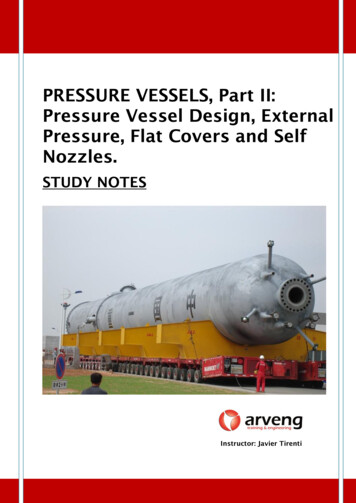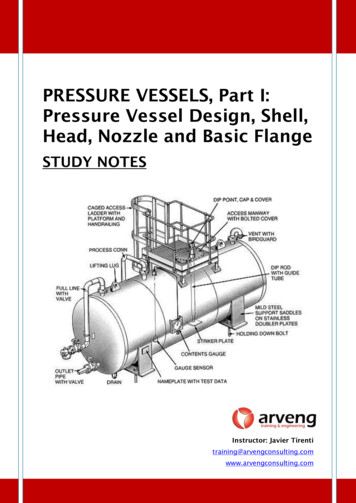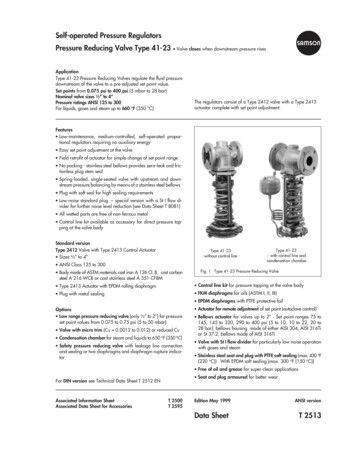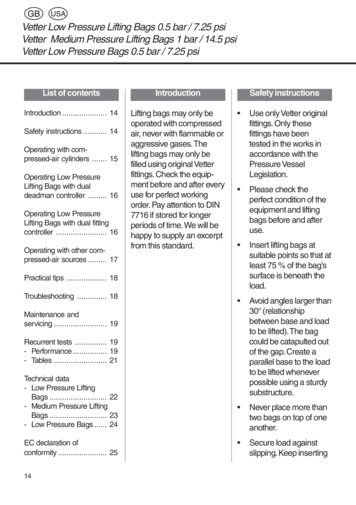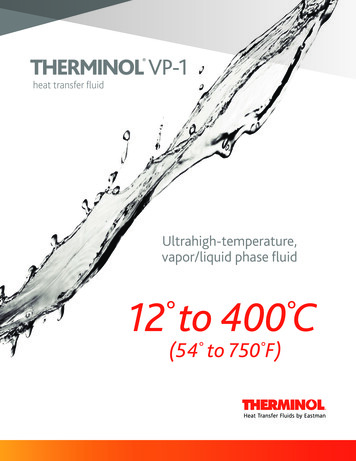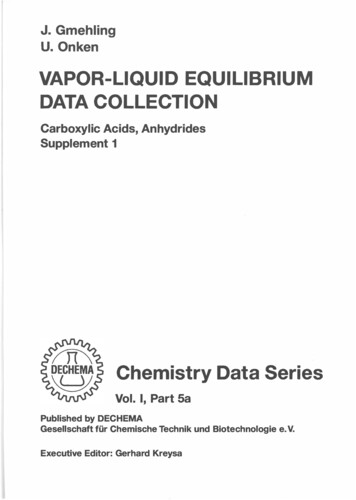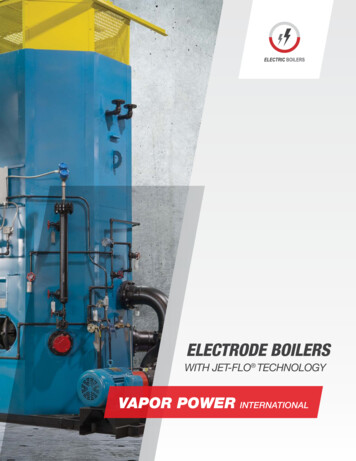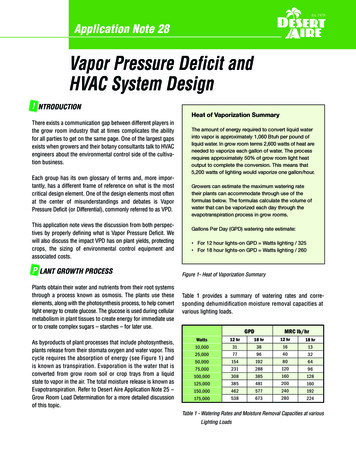
Transcription
Est.1978Application Note 28Vapor Pressure Deficit andHVAC System DesignINTRODUCTIONHeat of Vaporization SummaryThere exists a communication gap between different players inthe grow room industry that at times complicates the abilityfor all parties to get on the same page. One of the largest gapsexists when growers and their botany consultants talk to HVACengineers about the environmental control side of the cultivation business.Each group has its own glossary of terms and, more importantly, has a different frame of reference on what is the mostcritical design element. One of the design elements most oftenat the center of misunderstandings and debates is VaporPressure Deficit (or Differential), commonly referred to as VPD.This application note views the discussion from both perspectives by properly defining what is Vapor Pressure Deficit. Wewill also discuss the impact VPD has on plant yields, protectingcrops, the sizing of environmental control equipment andassociated costs.P LANT GROWTH PROCESSPlants obtain their water and nutrients from their root systemsthrough a process known as osmosis. The plants use theseelements, along with the photosynthesis process, to help convertlight energy to create glucose. The glucose is used during cellularmetabolism in plant tissues to create energy for immediate useor to create complex sugars – starches – for later use.The amount of energy required to convert liquid waterinto vapor is approximately 1,060 Btuh per pound ofliquid water. In grow room terms 2,600 watts of heat areneeded to vaporize each gallon of water. The processrequires approximately 50% of grow room light heatoutput to complete the conversion. This means that5,200 watts of lighting would vaporize one gallon/hour.Growers can estimate the maximum watering ratetheir plants can accommodate through use of theformulas below. The formulas calculate the volume ofwater that can be vaporized each day through theevapotranspiration process in grow rooms.Gallons Per Day (GPD) watering rate estimate: -VY OV\Y SPNO[ZɫVU .7 H[[Z SPNO[PUN -VY OV\Y SPNO[ZɫVU .7 H[[Z SPNO[PUN Figure 1- Heat of Vaporization SummaryTable 1 provides a summary of watering rates and corresponding dehumidification moisture removal capacities atvarious lighting loads.GPDAs byproducts of plant processes that include photosynthesis,plants release from their stomata oxygen and water vapor. Thiscycle requires the absorption of energy (see Figure 1) andis known as transpiration. Evaporation is the water that isconverted from grow room soil or crop trays from a liquidstate to vapor in the air. The total moisture release is known asEvapotranspiration. Refer to Desert Aire Application Note 25 ‐Grow Room Load Determination for a more detailed discussionof this topic.MRC lb/hrWatts12 hr18 hr12 0150,000462577240192175,00053867328022418 hrTable 1 - Watering Rates and Moisture Removal Capacities at variousLighting Loads
APPLICATION NOTE 28Vapor Pressure Deficit and HVAC System DesignColder temperatures tend to slow down plant growthbecause the rate of photosynthesis is reduced.Temperatures that approach 65 F (18 C) or lower are likelyto retard plant growth. In addition, at these lower temperatures the water in the root system begins to lose its abilityto hold dissolved oxygen. This allows pathogens to multiply,as those pathogens that weaken plants grow better withless oxygen. Thus, plants are more susceptible to certaintypes of mold when grow rooms are cool, especially ifgrow rooms are also damp. Indoor plants are much moresusceptible to cold than plants grown outdoors.When temperatures rise above 80 F, the rate of cannabisgrowth slows. The cannabis plants must use part of theirenergy to dissipate heat and to keep their water contentconstant. The rate of growth continues to slow as thetemperature rises. Photosynthesis and plant growth ceasealtogether somewhere above 90 F.M OLD & MILDEWAir with a high Relative Humidity (RH), greater than 80%RH, can create an environment conducive to the creationof mold and mildew. During this high RH condition plantstomata close, eliminating the transpiration of moisturefrom plant leaves. Instead, water can permeate the leavesor remain on them in the form of droplets and puddles.This provides the setting for quick mold and mildew formation.V APOR PRESSURE DEFICITVapor pressure deficit is a metric that indicates the evapotranspiration potential of grow rooms based on currenttemperatures and humidity levels. The value is the deficit ordifferential between the pressure exerted by the moistureat a specific room condition, and the pressure at saturation.The assumption is made that the surface conditions ofplant leaves are equal to that of the saturated conditionssurrounding them.When a space is at 100% relative humidity no further watercan be absorbed by the air, consequently no further evapotranspiration can occur from plants. When the temperatureincreases, plants will need to transpire more. Growers andtheir HVAC systems must control VPD levels to ensure plantscan transpire.On the other end of the spectrum, when the relative humiditygets too low, then stomata will also close to try and preservethe moisture in plants. This weakens the plants and makesthem more susceptible to disease, just as humans in stressedstates become susceptible to illness.We should note that VPD and RH are inversely proportional toone another when the air temperature is static. A high VPD isassociated with a low RH while the inverse is true that a lowVPD occurs at a high RH.VPD is a direct method of evaluating the potential water stresson plants by providing growers with a predictive value ofexpected evapotranspiration. Growers are more familiar withRH, but the key element of this metric is the term “relative,”as this value does not reflect the absolute moisture in the airunless the simultaneous temperature is known. Refer toDesert Aire Technical Bulletin #3 – Dehumidification andthe Psychrometric Chart for a detailed discussion. RH is ameasure of what percentage of moisture is in the air at thatspecific temperature.The vapor pressure and dewpoint are direct measures ofthe amount of moisture in air. The indoor grow industry hasused vapor pressure because it provides the best link to planthealth. Vapor pressure accounts for both temperature andhumidity levels. This is important because growers may wantto change the temperatures for day vs. night, different stagesof growth, and different product strains or types.P SYCHROMETRIC DEFINITIONVapor pressure deficit can be demonstrated on a psychrometric chart. The example below demonstrates the change in thevapor pressure at a fixed temperature. The calculations canalso easily be completed at other conditions.
APPLICATION NOTE 28Vapor Pressure Deficit and HVAC System DesignFigure 2 - VDP plotted on psychrometric .05542.26102.466645%Table 2 - VPD values for Cannabis Plants in the Vegetative Stage e 3 - VPD values for Cannabis Plants in the Flowering Stage (kPa)Table 2 and Table 3 display VPD values at a range of temperatures and relative humidities for cannabis plants in thevegetative and flowering stages respectively. The green bandsare typical target operating ranges. As will be explained later,the choices of temperature and relative humidity will have asignificant impact on the sizing and totalownership costs of HVAC equipment. Oncegrowers establish target VPDs, they shouldselect conditions to minimize the capital andoperational costs of environmental controlequipment.The control and management of indoor growenvironments requires an understanding ofcrop types as well as desirable crop temperatures, relative humidities and vapor pressures.The photosynthesis requirements of plantsmust also be understood.Vapor pressure deficits indicate the evapotranspiration potential of grow rooms and1.77872.0982their plant canopies. Ideal VPDs change with2.4666the different stages of plant growth and varywith the types of lighting used in growrooms. Vapor pressure deficits can be determined bylooking up corresponding values on a psychrometricchart or through calculations using known formulas.Today these formulas are readily available in apps orspreadsheets. The most common unit of measure forgrowers is kilopascals (kPa). Design engineers typicallyuse either kPa or inches of Mercury (in Hg).1.5025
APPLICATION NOTE 28Vapor Pressure Deficit and HVAC System DesignVapor Pressure Conversion FactorsThe following conversion factors can be used totranslate between vapor pressure values used bygrowers and engineers.kPa 3.386 x in Hgin Hg 0.296 x kPaHectoPascals 10 x kPa or 33.86 x in HgFigure 3 - Vapor Pressure Conversion FactorsMost plants will have a unique VPD requirement for individual stages of growth. These VPD values may be different forlights on vs. lights off modes. Botanists generally list thegrowth stages of plants as the following: Germination / Cloning Vegetative Flowering or early fruit generation Mature fruit formationAt 100% RH, the VPD is zero. A target VPD rate for optimized transpiration generally falls within a range of 0.5 to 1.5kPa depending on the growth stage of the plant. By alteringthe VPD, growers can regulate the uptake of water and nutrients by plants. Thus VPD becomes a metric that growers andthe engineers designing their climate control systems canuse as the basis of understanding the grow room conditionsthey seek to create.Stage of GrowthAir TempRHVPDWatering RateCloning70 F(21.1 C)80%0 to 0.2 kPa(0 to 0.06 in Hg)Saturated soilVegetative78 F(25.6 C)70%0.8 to 1.1 kPa(0.24 to 0.33 in Hg)Medium as plant is smaller,producing leaves for supportEarly Flowering75 F(23.9 C)60%1.0 to 1.4 kPa(0.30 to 0.41 in Hg)Maximum to grow full budsLate Flowering75 F(23.9 C)50%1.3 to 1.5 kPa(0.39 to 0.44 in Hg)Medium to start to dry out andpreserve terpenesTable 4 - Typical Cannabis VPD valuesV PD IMPACT ON GROWTHWhen VPD is held constant, growth and yield will improve withincreasing temperature. In contrast, growth declines when theVPD is increased and temperature is held constant. The sloweror reduced growth is in response to plants reaching a maximumtranspiration rate.When VPDs are relatively high, between 0.5 and 1.2 kPa,plants increase growth‐inducing transpiration by openingstomata and releasing a considerable amount of water vaporinto the air. This increase in transpiration results in an increasein plant photosynthetic activity, requiring more nutrients toimprove overall growth. However, at high VPD ( 1.5 kPa) theplant would close its stomata to avoid releasing water vapor tothe air, preventing dehydration due to excessive transpiration.In flowering rooms where the VPD is too low ( 0.80 kPa),plants close their stomata to prevent releasing more water intothe air. This reduces transpiration and the rate of photosynthesis. These reductions would significantly reduce crop yields.VPD is essential when it comes to providing the best conditions for the development of plants, to understanding thewatering requirements according to the nutrients used, andadjusting them correctly to meet grower expectations. Thebest way to keep a suitable VPD value is to use an integratedenvironmental control system to maintain a tight temperatureand dewpoint condition in the space.Understanding the fundamental impact that temperature andVPD have on growth and yield, it is important for growers todefine these variables first as they plan their facilities. Oncethose have been determined, growers can decide on relativehumidity targets for their grow spaces.Table 5 presents values for relative humidities at certain temperatures and VPDs that are required to maintain ideal growing conditions.
APPLICATION NOTE 28Vapor Pressure Deficit and HVAC System DesignVegVDP (kPa)Fahrenheit Celsius0.8MinEarly Flower1.1Max1Min1.4MaxLate Flower1.3Min1.5Temperature ( F tive Humidity62%57%51%44%6618.963%49%53%36%40%31%Wet Bulb ( F)71.967.061.956.86719.464%50%55%38%42%33%Dewpoint ( F)67.761.654.747.16820.065%52%57%40%44%35%VDP (kPa)1.41.41.41.4HVAC Size (nominal ncrease in sizeTable 5 - Relative Humidities Required to Create Target VPDValues (Lights-on Mode)H VAC PERFORMANCEThe impact of temperature and relative humidity on equipmentperformance is a significant element in the cost of purchasingand installing HVAC equipment. These operational variableswill also influence the amount of energy required to operatethe HVAC equipment.Table 6 displays the size of the environmental control systemneeded to remove the moisture in an indoor flowering roomthat has 2,000 square feet of cannabis canopy, watered at a rateof 270 gallons per day. Note that all of these design conditionshave the same vapor pressure deficit. This analysis is for a maximum watering rate in a flowering room at full plant growth.A key design consideration is the selection of the designtemperature. As Table 6 demonstrates, while a constantgrowth potential is being maintained for the plants, the designtemperature and relative humidity selected will dictate theTable 6 - System performance at different entering air design conditionsactual size and total ownership costs of the environmentalcontrol system needed. If the grower selects design condition#4, initial capital expenditures or first costs for the increasedsystem size will be more than double the baseline system #1.Then the grower will incur higher annual operational costs tomaintain this environment at the lower design conditions.A IR DISTRIBUTIONAir distribution is an important component in optimizing thecapital costs of grow room climate control systems, andensuring the health of crops. If good air distribution systemsare utilized, growers can obtain very uniform climatic conditionsin grow rooms and eliminate the possibility of damagingmicroclimates under plant canopies. With homogenous environments the growers can operate at higher air temperaturesand still ensure appropriate vapor pressure deficits across andthroughout plant canopies. This eliminates the possibility ofmold and mildew forming while improving the growth rateand quality of plants.Air Change CalculationA method to measure the effectiveness of your airdistribution system is to calculate the airchanges in the space. To calculate HVAC system airchanges, use the following formula:Air Change Total cubic feet of room[Cubic feet per minute (CFM) of thesystems / 60 minutes per hour]Figure 4 - Calculating Air Changes
APPLICATION NOTE 28Vapor Pressure Deficit and HVAC System DesignThe targeted air change for environmental control systemsshould be a minimum of eight air changes per hour. Mostgrowers install supplemental fans to provide additionalrecirculation capacity by aiming the fans at plant canopies.The value of these fans is they move air at target conditionswhile the HVAC supply air might need to be at temperaturesas cold as 55 F.For example, if the grow space is maintained at 78 F db and57% RH the grow space dewpoint is 61.5 F. If any of theHVAC supply air is below this value and directly hits theplants this will create condensation on the plants. Thepotential for mold and fungi to grow is significant.This is one of the main reasons why discharge supply airfrom HVAC systems should be directed toward the walls andopen aisle areas so it does not strike the plants. Additionalrecirculation fans will assist in blending the HVAC supply airwith the room air to quickly create a mixture that is abovethe room dewpoint.An example of a desirable supply air and return air configuration is shown in Figure 5. Note supply air is directed alonggrow room walls. Return air vents are at high and mediumvertical positions in the wall opposite the supply air entry point.C ONCLUSIONSGrowers and HVAC design engineers must agree on whatthe most challenging environmental design conditionswill be for each grow room depending on its cultivation andproduction purpose. Typically these peak load designconditions will be for lights‐on modes with the plants at themaximum watering rate for that growth stage. Partial loadconditions will be met if the systems have the capacity forpeak loads and proper environmental controls are part of theoverall system designs. Refer to Desert Aire ApplicationNote 26 ‐ Grow Room Environmental Control, for moreinformation on controlling grow room climates.Due to capital cost implications, growers need to carefullydefine the desired air temperatures and vapor pressuredeficits they will use to produce maximum yields. Arbitrarilychoosing low temperatures to avoid condensation problemsdoes not provide proper solutions.Understanding the interplay of watering rates, plant growthcycles, room temperatures, humidity requirements and airdistribution is essential. All must be carefully orchestratedto achieve successful grow room designs. Detailed communication between growers and HVAC design engineers musttake place before the engineers begin designing grow roomenvironmental control systems.Figure 5 - Top view of desirable grow room duct layoutOPTIMIZING SOLUTIONS THROUGH SUPERIOR DEHUMIDIFICATION TECHNOLOGYN120 W18485 Friestadt Road, Germantown, WI 53022 sales@desert-aire.com128 2019/01
Vapor Pressure Deficit and HVAC System Design significant impact on the sizing and total ownership costs of HVAC equipment. Once growers establish target VPDs, they should select conditions to minimize the capital and operational costs of environmental control e
